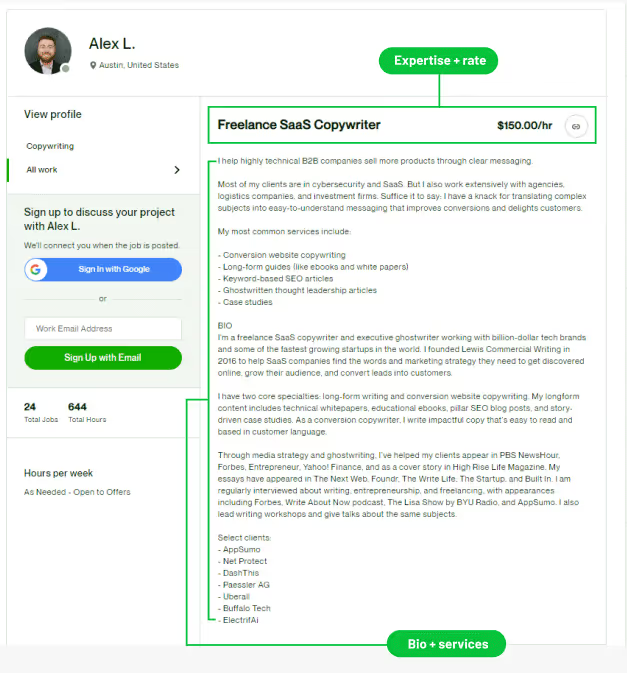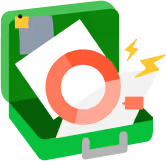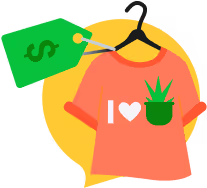
This article is your resource for starting and growing an online business.
We’ve developed this comprehensive guide based on the real success stories of ecommerce owners, freelancers, SaaS entrepreneurs, and full-time content creators. Here, we cover the A-to-Z on how to start an online business in 2024.
By the end of this guide, you'll learn:
Here’s the reality: starting a business can feel overwhelming at the beginning. But if you have a vision and you’re willing to put in the work, there’s never been a more exciting time to start.
The big secret about launching a successful business is that you don’t have to dream up the next world-changing idea. The best ingredient to starting any business is knowing the unique skills and knowledge you bring to the table—and then leveraging them to help solve the problems of your customers.
Ready to get started? Read further to discover how to start your own business today!
Table of Contents
Every year, the difference between online and offline businesses blurs more and more. Even physical stores usually have online storefronts. Your local lawn care company probably has a website that collects reviews, sets up appointments, and markets the business.
For this article, we're defining online businesses as companies that deliver services or products online. That includes ecommerce stores, content creator brands, SaaS companies, and online course creators. It doesn’t include companies that merely have an online presence but only deliver their products and services in person or via a physical store.
Here are a quick rundown of differences between an online business and a phyical business:




.avif)
This post will dive into the specifics of starting freelance, ecommerce, content creation, and SaaS businesses. But before we go too deep, let’s cover how to start a business online from a high level.
Start by considering where your personal interests and strengths overlap. If you’re reading this guide, you likely already have a few ideas. Now it’s time to choose one and double down. Do you have a rare and valuable skill that you can sell as a service or use to get a specific type of company off the ground? Do you have a passion for teaching or writing deeply about a niche topic? These are all skills that you can leverage to build an online business. But you can’t move on to product creation, marketing, or scaling phases until you determine a few potentially profitable business ideas to you can work on.
Don’t overcomplicate your business idea. If your product or service meets a real market need, then you can build out all the fun bells and whistles later. For now, you just need to prove the concept, which requires selling a version of your product or service that you can put together in a weekend. For software creators, this is pretty straightforward: Focus on the core features. For content creators, this might mean creating short-form content about a subject to gauge interest before you film a full course or write a book on the subject. Regardless, the idea is simple: Test before you invest.
Try to find people outside of your family and closest friends. Sure, they can be your customers too, but during this early stage, you want to prove demand for your offerings. That means selling to people who have a real need or interest.
As you serve customers, you’ll inevitably hear feedback from people who love, hate, or simply don’t care about what you’re selling. All feedback should be considered with a grain of salt. However, customer feedback is one of the best ways to hone your product into something people truly get excited to buy.
You’ll need to decide a business structure. This determines how you report and pay taxes to the government. From there, create a financial plan to determine how much to save for taxes, what expenses are necessary to keep the business running, and how you’ll operate business as a side hustle or scale it into your full-time job.
Once the foundation is in place, you can begin improving every element of your business. Learn how to start a website and implement scalable marketing tactics like digital ads or SEO. Look into faster or more efficient ways to create or deliver your product. Every business has potential areas of growth, optimization, or improvement.
Now that we’ve given you a general overview on how to start an online business, let’s get more granular. Here are four common online business ideas (and how to build them).


The easiest business to start online is offering a professional service. Almost every business needs writers, designers, and developers—but not every business has the budget or workload to hire them full time. You can fill that need and earn a good living online through freelance or consulting services.

Ecommerce is one of the most popular online business ideas out there. From selling homemade jewelry on Etsy to dropshipping clothes and tools on Amazon, online shopping has exploded in popularity—and it’s not going away. If you have a physical product to sell online, you may be able to earn a good living through an ecommerce store.

One of the fastest growing types of online business is content creation. This includes YouTubers, bloggers, newsletter creators, social media influencers, and podcasters. Once seen as an unrealistic job reserved for only the lucky few, content creation is becoming more accessible every year. The key is to find a niche where you’re uniquely qualified to help or entertain a very specific audience.

SaaS stands for software as a service. Every company these days uses some kind of software. Whether it’s a payment processor to accept credit card payments or an email service provider for sending promotional newsletters, SaaS tools are everywhere. But this industry is still fairly new and there are endless opportunities for people to launch their own SaaS to sell online.

At the beginning of 2016, I (hi, it’s me—the author of this article) resigned from my 9-to-5 job with no idea what I’d do next. A friend told me that I should learn about freelance copywriting. In his words: “Alex, you’re a good writer and you live in a tech city. These developers know how to build great products but don’t know how to tell anyone what they’ve made. Why don’t you just make a living writing for tech companies as a freelancer?” Long story short: I followed my friend’s advice. Six years later, I run a six-figure one-person writing business.
Here are several steps to launching a successful freelance business.

Becoming a freelancer or selling a professional service is the easiest business to start because all you need is 1) you and 2) your time. However, to launch a freelance business, you need to begin with a marketable skill. And no, you don’t have to be a world-class expert in that skill. You just need to be better at your skill than your clients.
Here are some of the most popular skills that people outsource to freelancers:
This is far from an exhaustive list. These are just a few of the most common skills that business owners look for.

One of the easiest ways to launch a freelance business is to create a profile on freelance websites. Think of these as project aggregate platforms. Business owners from all over the world post projects they need accomplished by a freelancer. Then freelancers submit proposals to win the gig.
It’s usually very easy to get started on these websites. Most just require you to fill out a simple profile and then begin offering your services.
Consider the pros and cons of freelancer platforms vs. building a personal website.
.avif)
.jpg)
.avif)
.avif)
Remember: freelancer websites attract a lot of competition. Your goal should be to create a profile that stands out. Here are some things to try:


It’s not enough to just create a profile. With all three of these freelance platforms, you’ll also need to bid on projects. Here are the elements of an effective proposal:

Here are three different ways to charge for your freelance services.
How do you determine your rates as a beginning freelancer?
This is one of the most common questions freelancers have in the early days. The easiest way to set rates is to consider:



Your income goals



The time it takes you to finish a project



The number of clients you can realistically handle
Start with the income goals. Let’s pretend that you’re a content writer who wants to earn $100,000 this year. That’s $8,333 per month. Since the average month has 20–23 working days, that comes out to about $362–$416 per day.
For easy math, let’s say you can finish one blog post in a day. To reach your income goal of $100,000, you’ll need to charge about $400 per blog post and write 21 blog posts per month.
All three of these variables—desired income, time per project, and client quantity—can be adjusted to change the outcome. But there’s a fourth factor that is equally important: what happens when you test these fees in real life by bidding on projects?
Calculating rates in your head doesn’t mean anything until you start bidding on projects. This is the ultimate feedback loop. If everyone hires you, you may be charging too little. If no one hires you, either your fees are too high or you should adjust something about the way you pitch your services.
One good resource to find comparable rates to your experience is looking at other bios. Find someone on Fiverr or Upwork with similar experience in your industry to get an idea of what you should charge. Here are a few more ideas:
(Setting freelance rates is a huge topic. If you’d like to learn more, see Freelancing and Consulting as a Side Hustle.)
Freelancers charge highly variable rates depending on the level of value that they offer with their services.

(Setting freelance rates is a huge topic. If you’d like to learn more, see Freelancing and Consulting as a Side Hustle.)
The surface-level value is time. Many freelancers get their earliest projects by simply having the time to create, edit, or design that others don’t. If a busy entrepreneur wants to create a YouTube channel, they may be a good video editor. But if they don’t have time to edit, they will need to outsource the work to someone else.
Saving someone time is a high value, but it’s the foundational value for your freelance business. The more benefits your skills offer, the higher you can raise your rates.
For example, a writer can save a business owner time by drafting blog posts. If that same blogger learns about search engine optimization, the value of their blog writing goes up significantly! Suddenly, the business owner isn’t just paying you to save them time—they’re paying you to boost their website’s discoverability.

You don’t need your own website on day one. In fact, freelancers can go years without creating a portfolio, as long as they have other ways to find clients (such as through Upwork).
However, there are clear benefits to having your personal website. This section will help get yours off the ground.
Your portfolio should be easy to navigate, with clear headings and concise descriptions of your work. For almost all freelance services, it’s also helpful for your portfolio to be visually appealing. You want to make sure you showcase your best work in the best way.
Here are five tips on how:

Fortunately, most freelancers don’t need a lot of clients to make their business sustainable. You just need a few good clients. Here are a few tactics for finding them:

Need courses, software, and guides to take your ecommerce business to the next level? Consider some of these tools.
.avif)
During a crossroads in her career, Shana Rehwald quit her social media job a month before Covid hit and launched her journal, Me-est Me, in March 2021. Since then, the journal has appeared in many prestigious publications including Cosmopolitan and the LA Times Holiday 2021 Gift Guide.
Shana says, “I’m still working all the time, but this time I get to make the choice to do that—instead of feeling like I have a boss to report to.”
There are tons of ways to build an ecommerce business. The essence of this style of company is that you sell goods and services online. While these goods can be physical or digital, we’ll focus on good ol’ tangible, physical products in this section.
Starting an ecommerce business comes down to five basic steps:
Let’s dive into each of those topics.

You can sell almost anything online these days. The best path to success is to focus on your strengths or unique advantages. Here are just a few ways to find good ecommerce product opportunities:
Brett Schmechel flips retail items like furniture and clothes online. Over the years, Brett has earned a skill for spotting deals. He frequents thrift stores, estate and garage sales, and online sites like Facebook marketplace. Brett refurbishes and promotes these items to sell at a profit.
''I love the flexibility that flipping provides. But even more, I am motivated by the environmental impact recycling items has. While I realize I am just one person, I strive to reduce demand for new production wherever I can. Flipping is one of the ways I do that.''

Next, determine how you’ll source the product. If you’re creating the product from scratch, you’ll need to find an affordable way to gather the material needed to create each one.
Flippers like Brett often rely on garage sales, Facebook Marketplace, and thrift stores to source their latest products. Meanwhile, dropshippers might find products on one website (like Alibaba) and sell them at a higher price on Amazon.
Many factors impact the price of an item. Often the higher the quantity you buy and the more you shop directly (i.e., without middlemen), the better your margin is for selling. If you can go right to the source and shop in bulk for the products you need, you may be able to sell your products for a higher profit.

There are three primary places to sell your products online:
Each of these places has pros and cons. Established businesses often do a combination of all three. But as a new business owner, it’s best to start with just one. You can always expand later after getting some traction and mitigate some of the cons of each platform individually.
.avif)
.avif)
.avif)
P.S. it’s easy to list and sell your digital product on AppSumo!
.avif)
.jpg)
.avif)

There are two primary ways to fulfill ecommerce orders:
Self-fulfillment is a great place for young ecommerce businesses to start. It involves the owner—you!—packaging and shipping every new order to each customer.
Since you’re just getting started, fulfilling your own orders will be the fastest and most cost-effective way to kickstart your company. If you’re a flipper like Brett, you can deliver furniture in person to customers for a fee.
The downside is the manual labor and inventory management. Many starting ecommerce businesses fill spare bedrooms, closets, and garage space with their inventory until it’s ordered.
Once your sales begin to outpace your ability to fulfill them on your own, you might consider using a third-party fulfillment service.
Third-party fulfillment services handle as little or as much as you want them to. They can track orders, ship and process returns, and provide fancy software for managing sales and inventory.
It’s worth noting that Amazon allows sellers to opt in to letting the company handle order fulfillment. In this case, Amazon charges a slightly higher fee to pick, pack, and ship customer orders on your behalf.

Now it’s time to think about sales and marketing. How will people discover your great products?

Learn more about all these marketing methods by downloading AppSumo’s Essential Marketing Start Guide for free.

Need courses, software, and guides to take your ecommerce business to the next level? Consider some of these tools.

Kat Harris has been blogging for 10 years. Her site, The Refined Woman, began as a fashion blog. Kat says, “From the beginning, I wanted it to be monetized. I didn’t just want to have a side hobby.”
It took Kat five or six years to realize the right direction for her blog. A big turning point came when she began asking her Instagram followers: Why do you follow me? What do you want to learn from me? “Instagram stories have been the best R&D,” says Kat.
Today, Kat continues to create content for her growing audience in the form of her blog and Instagram posts, a podcast, and other digital resources.

One of the big decisions you’ll face as a beginning content creator is choosing your niche. Some of the most successful content creators build their influence by appealing to a highly specific audience. As a general rule, the finer your niche, the more likely you are to achieve success.
So, how do you choose your topic? It’s time for some soul searching. Ask yourself these questions:
If you still can’t think of anything, try sending those exact questions to your closest friends. Your expertise and interests might be obvious to everyone around you.

You don’t have to be an expert in your subject matter to create a powerful and helpful information brand. Many top content creators didn’t begin as experts in their core subject at all. They just went above and beyond to learn and research their topics before creating content to ensure their videos, articles, and podcasts truly added value.
As you select your topic, remember that you can approach it as an expert or a journalist. Experts share from what they already know and have experienced. Journalists teach from dedicated research.

You don’t need a million followers to build a successful content business. In fact, the barrier to entry is much, much lower. In his classic article “1,000 True Fans,” editor and publisher Kevin Kelly writes that to earn a good living, all you need is 1,000 people who believe in you enough to spend $100 per year on your courses, products, or services. That comes out to $100,000 per year.
The most successful content creators play the long game. They also have goals beyond merely growing their audience to a particular size. People follow them because of their shared interest.
As authoronce described, the most successful content creators become “avatars'' of a specific idea online. As you publish more and more content, anyone who shares your belief or connects with your message may become a new follower.
People can tell the difference between someone trying to hack their way to a larger audience and someone who holds a genuine interest in their subject matter. But you can’t build an audience purely on enthusiasm—you must also be pragmatic and get the right system and tools.
The most successful content creators tend to be people who understand the fundamentals of audience growth while also maintaining a true interest in their subject matter. Here are some practical steps for building an online audience:

Top content creators may have profiles on many channels. But if you look a little closer, they always prioritize one or two channels above everything else.
How do you choose which channels to prioritize versus which ones to simply manage?
Think of this as two separate operations. The first is your core platform. Every other channel is your distribution engine. The core channel is usually the most easy to monetize.

As you create content on your core platform, you will share and repurpose that content on your distribution channels to get the word out. For example, you can splice clips from your YouTube video to create multiple TikTok videos.
A great example is James Clear. Clear has accumulated well over 1 million email subscribers to his newsletter. To market the newsletter, Clear publishes standalone snippets from the newsletter to Twitter, Instagram, and probably a few other social media channels.

There are many ways to monetize a digital audience. Here are just some of our favorites:

Need courses, software, and guides to take your content creator business to the next level? Consider some of these tools.

Leo Bassam freelanced for several years and realized the difficulty of juggling multiple projects. He was tired of jumping between apps and managing multiple subscriptions just to do his job.
So he created Plutio, a project management software for freelancers. He designed the first version of the tool and hired a programmer to begin development. Since then, Plutio has grown quickly, including having multiple popular launches on AppSumo.

The most successful businesses don’t try to reinvent the wheel. The founders start by finding a clear problem that people want to solve. Then, they create a product or service that meets that need. That's how successful SaaS founders find their profitable business ideas.
Building a successful SaaS product requires more upfront work than most online business ideas on this list. You must design and develop the tool, which can require weeks or months of work.
That’s why it’s highly recommended to begin with a very clear and focused problem that you’d like to solve. Like Leo from Plutio, one of the best ways to find a problem is through self-reflection. What problems do you face at your current job that could be solved through software?
Here are a few other ways to find problems to tackle:

One of the most common mistakes SaaS founders make is feature bloat. They begin developing a tool to solve one problem. Then, they come up with additional ideas. Those new ideas turn into additional weeks of development. Eventually, you have a feature-packed tool that no one has used except the developer. A better approach is to begin with what’s called an MVP (minimum viable product). This is the lean version of your tool. You create this by first asking yourself: what is the bare minimum I need to see if there’s truly demand for solving this problem? When developing your MVP, style, structure, and features matter less than simplicity: does the tool solve what you say it will, no matter how clunky?
Here are a few ideas for developing an MVP:



Build out your functions and automations using existing tools like Notion, Google Sheets, or Zapier



Perform all the services manually



Test your assumptions on similar existing products
Once you have this first version of the tool, it’s time to begin testing it. Begin with a small market. For example, Uber was tested in New York City and San Francisco. New users literally had to email the founders just to access the tool.
Once you prove the concept through gaining initial users, you can begin fleshing out a better version of the tool.

Once you’ve proven the initial concept for your SaaS, it’s time to move beyond MVP. How do you begin creating a user-friendly SaaS? Start with feedback from your current users.
You can begin receiving feedback by creating a survey or by simply emailing customers to hear about their experience. Customers won’t necessarily be able to tell you the exact features they’re looking for. But they will be able to communicate challenges they’re facing. They will also be able to tell you about glitches or confusing parts of your tool.
A big part of user experience is thinking about what you enjoy about your favorite websites and apps. Here are some examples:
Think of it this way: No one wants to use software that makes their life more difficult. The better your user experience, the more likely users are to return to your app.This information should fuel you to turn your MVP into a full-blown software like the one you envisioned in the beginning.

Dilyar Buzan, founder of AISEO, says that one of the hardest parts of launching any SaaS business is finding the first 10 clients. But because it’s a unique challenge, it’s also one of the most memorable phases for starting entrepreneurs.
Want to launch with a bang?
Here are six elements of a successful product launch strategy.

There are several ways to monetize a SaaS business. Here are just a few ideas:

Need courses, software, and guides to take your SaaS business to the next level? Consider some of these tools.
.avif)
Get inspiration on 6 digital products you should make in 2024!
.avif)
Check out our video on how to create and sell a digital product online
.avif)
List it on AppSumo to potentially drive more sales

Many online business owners don’t settle for just one business model.
Consider Jane Friedman. Jane is an author and blogger covering the publishing industry. So, how does she make a living? From multiple sources!
Jane is a freelance writer, book author, online teacher, and conference speaker, plus she sells a premium newsletter. Looking at her 2020 income breakdown, Jane had eight sources of revenue, with no stream accounting for more than 48% of her income.
It’s worth mentioning that Jane didn’t accumulate these income streams at the same time overnight. When you’re starting a business, it’s best to focus on delivering just one service or offering. As you see success with that part of your business, you can choose to expand into additional income streams. Here’s another example of online business owners creating multiple income streams.
Here’s another example of online business owners creating multiple income streams.
The web has made it possible for people to leverage their personal name, ideas, and story to gain a following. We call this building a personal brand.
As we covered in the previous section, personal brands often offer more than just one way for the owner of the business to make money. Some customers want to learn from them. Some people want to hire them. Some people just want to buy their products. Each one of these paths is a different online business ideas to tap into—and potential income stream.
There are many ways to define a personal brand. But we don’t have to complicate anything. Just ask yourself: Are you creating content and products that people are excited to consume every time? Here are some action steps for developing a personal brand:
.avif)
Here’s a resource on creating a personal brand to get you started.
According to accountants, one of the biggest things new business owners overlook their first year in business is taxes. When you’re used to an employer withholding tax on your behalf, it’s easy to forget to set them aside for yourself when you become self-employed.
At the end of a successful first year in business, the government will want to share in your success—by handing you a tax bill.
But don’t fret. The key here is preparation. Speak with a tax professional in your country to learn the best practices for staying ahead of the tax season. A short consultation can go a long way.
One of the popular question people have with how to start an online business is all about incorprating a business identity and dealing with legal issues. I've left this out intentionally till the end because it varies for different countries and regions.
(This section is written based on the U.S. standards and should not be taken as legal advice.)
The government wants to know about your latest business. In the United States, when you begin making sales before registering your business, you are considered an unincorporated sole proprietor.
"A sole proprietorship is the simplest and most common structure chosen to start a business. It is an unincorporated business owned and run by one individual with no distinction between the business and the owner. You are entitled to all profits and are responsible for all your business’s debts, losses and liabilities.
No formal action is required to form a sole proprietorship. If you are the only owner, this status automatically comes from your business activities. In fact, you may already own one without knowing it. If you are a freelance graphic designer, for example, you are a sole proprietor."
In other words, you don’t have to wait in long lines at a government building just to start selling your ebook or freelance services. Selling items related to agriculture and firearms require special government licenses. But most online businesses do not require any pre-registration before you launch.
However, as your business grows, there may be certain advantages to registering or incorporating your business. There are multiple types of business entities. Some of these entities offer better legal protection, a more advantageous tax structure, or the ability to divide business ownership amongst multiple people.
If you’re wondering what’s best for your business, it’s best to speak with a tax advisor.
.avif)
Resources for starting a business in Europe.
You don’t need to have every detail of your business figured out before you launch. In fact, we highly recommend launching a minimum viable product just to make sure your product or service has real demand before you invest.
With that said, you do want to figure out some core things about your side hustle before you go full time into the business. Don’t quit your day job until you’ve done one of the following:
When you’re ready to jump into being a full-time creator, we’ll be here.
Starting an online business comes with many learning curves. You’ll need to become a jack of all subjects, including marketing, sales, accounting, project management, and more.
This sounds scarier than it is in practice. Some things you’ll learn will feel intimidating at first. But the good news is that you don’t have to know everything from day one.
As you meet other creators and founders, learn through practice, YouTube, and books, and simply experiment in your business, you’ll move forward. One day, you’ll look back and realize the dozens of skills you’ve gained.
As your business grows, you can find tools or build a team around areas of the business that you no longer want to do on your own.

Starting an online business can be a lonely and intimidating journey. Fortunately, there are hundreds of welcoming small business communities all over the web that you can take advantage of.
There are many benefits to finding a supportive business community. For example, more experienced entrepreneurs can refer to your work or provide recommendations based on their network and experience. A community also gives you a chance to read the success stories and mistakes of other entrepreneurs, so that you can learn by example. Plus, it’s just inspiring to see what other people in your city or industry are building.
Here are just a few places to connect with fellow entrepreneurs:
You can also subscribe to entrepreneur-focused newsletters, like:

There are hundreds of reasons why people start businesses. Let’s talk about some of the most common ones.
When you’re in the early days of learning how to start an online business, you might start to doubt yourself. Do you really have what it takes to be an entrepreneur? What will friends and family think? What will your dog think?
You don’t need anyone’s permission to start a business. (And your dog has always believed in you, we promise.)
There’s a term for feeling unqualified to start something: imposter syndrome.
The good news is that everyone—from your favorite artist to the most successful business owner—experiences imposter syndrome sometimes. Here’s what Maya Angelou says about it.
"I have written 11 books, but each time I think, ‘uh oh, they’re going to find out now. I’ve run a game on everybody, and they’re going to find me out."
In other words, every artist and business owner faces personal doubts and imposter syndrome. But we’re here to say: you’ve got this.

Now we've covered everything on how to start an online business. Here's the catch: Entrepreneurship isn’t easy. But it’s more accessible than many people think. Whether you’re selling skills as a freelancer, information as a content creator, physical products as an ecommerce store owner, or a SaaS product as a founder, the journey is often worth the challenges.
We created this guide to make your path to starting an online business a little easier with stories, tips, resources, and products for turning your idea into a real business.
Now it’s time to move the needle on your idea. Doing the research is important to the entrepreneurial journey. But the most valuable step is getting started.
You’ve got what it takes to be an incredible creator. And when you need tools to run your business, AppSumo is here to help.
